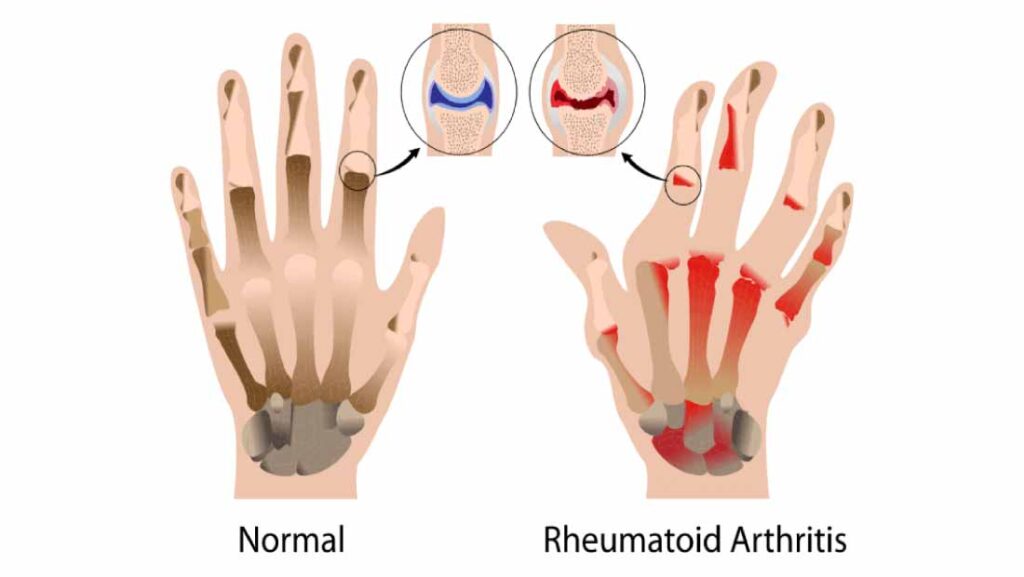If you suffer from rheumatoid arthritis (RA), you are not alone. There are many causes and treatments for the disease, including a variety of medications. Occupational therapy can also be helpful in helping people maintain their function. Physical therapy can be especially helpful for people with RA who need a little extra help getting around.
Symptoms
The most common symptoms of RA are inflammation and joint pain, which increase during flare-ups and exacerbations and decrease during remission. Symptoms commonly affect the hands, wrists, and knees, although they can also affect other parts of the body, such as the lungs and heart.
Rheumatoid arthritis can have serious complications and it is important to get proper diagnosis and treatment to prevent complications. It’s important to recognize the signs and symptoms of rheumatoid arthritis to make sure you’re taking the right medication.
Rheumatoid arthritis is an autoimmune disease that causes inflammation in the joints. This inflammation causes pain, swelling and increased heat in the affected joints. If left untreated, the inflammation can spread to other parts of the body and permanently damage the joints. Surgery may be needed to repair damaged joints.
The first signs of RA can be gradual and subtle, and joint swelling develops in the morning. The condition can spread to other joints and symptoms can progress very quickly. The first symptoms of RA usually begin in the small bones of the hands and fingers, or at the base of the fingers and wrists. In addition to these symptoms, patients with early RA may also experience morning stiffness. Some RA patients may also have fatigue or even weight loss.
Causes
Rheumatoid arthritis (RA) is a joint disorder that affects approximately 1% of the population. It is more inflammatory and systemic than osteoarthritis. Its symptoms include a loss of function in the joints. The disease affects the bones and joints of the hips, shoulders, elbows, hands, and feet. The symptoms of RA vary among individuals.
Treatment for RA focuses on reducing pain and inflammation. Nonsteroidal anti-inflammatory drugs, such as aspirin and ibuprofen, can help relieve pain by reducing the production of prostaglandins, the chemical messengers that cause inflammation. Opioid pain relievers are also used to treat RA, but they can have side effects.
Although there is no definitive cause for RA, studies indicate that certain environmental factors can affect the disease. One of these factors is high stress. Large amounts of stress can affect the immune system, endocrine system, and nervous system. Chronic stress can result in a significant increase in inflammation. Environmental factors such as smoking can also increase the risk of RA.
While rheumatoid arthritis has many causes, the best way to prevent its progression is to seek treatment as soon as possible. Early treatment will prevent the disease from getting worse and reduce the risk of joint damage. Unlike other diseases, rheumatoid arthritis is an autoimmune disease, meaning it attacks joint cells. When this happens, the disease damages nearby cartilage and bone, causing swelling and stiffness.
Treatment
Fortunately, rheumatoid arthritis is treatable and treatment options include a variety of complementary and alternative therapies. These treatments can help reduce pain and stiffness, restore range of motion, and restore normal function. Rheumatoid arthritis treatments may also include surgery, which can help relieve pressure on nerves and repair damaged joints. People with RA may also benefit from counseling and other forms of support.
Rheumatoid arthritis is a condition caused by a failure of the immune system. This misfire causes the synovial membrane to become inflamed and thickened, limiting joint movement and causing pain. The inflammation also damages bones and cartilage, leaving joints swollen and unstable. These symptoms can exacerbate the condition and make it difficult for you to function normally.
Short-term corticosteroid use may reduce symptoms of rheumatoid arthritis, but these medications should be taken with caution because they can cause serious side effects. Corticosteroids come in the form of pills, injections, or intravenous infusions and work quickly to reduce inflammation. Low doses of oral corticosteroids can provide relief in as little as one day, while high doses of intravenous injections can achieve similar results in a shorter period of time.
Diet
Many people with rheumatoid arthritis feel that diet can have a positive impact on their disease. Studies have shown that a diet rich in anti-inflammatory foods can decrease joint inflammation, decrease pain, and slow the progression of the disease. In addition, an anti-inflammatory diet can help people manage their weight and improve their symptoms.
However, dietary interventions are difficult to implement in clinical trials. Patients are required to modify their lifestyle, which can lead to a high dropout rate. In addition, studies must have adequate power to capture accurate results. There are several factors that influence dietary intake, including the presence of potential confounders.
Research suggests that dietary changes may influence the human gut microbiome. Inflammation is a common symptom of RA and changes in the gut microbiome can be a way to alter disease activity. For example, diets rich in fruits and vegetables can improve the immune system activity of the disease.
Research has shown that omega-3 polyunsaturated fatty acids may protect against rheumatoid arthritis. Omega-3s may improve immune function by decreasing inflammation. It can also elevate autophagy in macrophages. However, the mechanisms underlying dietary interventions are not yet fully understood.
Exercise for Rheumatoid Arthritis
Fortunately, the right exercise routine for RA can make a big difference in the quality of your life. It can boost energy levels, help you sleep better, and improve overall physical function. However, motivation to exercise is a big challenge for many people with RA. While there is no “one-size-fits-all” plan, you should focus on staying as active as your condition allows.
In addition, combining physical therapy with exercise can help reduce hand pain, a common symptom of RA. However, most studies are inconsistent in how much exercise helps reduce pain and improve hand function. In addition, RA patients tend to have inconsistent pain scores, so an exercise program can make a big difference even if it’s not effective in a certain area.
If you have RA and are looking for an exercise routine, you should start slowly and gradually increase your pace. You should also wear supportive sports shoes to reduce strain on your joints. Another good option is to exercise in the water. The natural resistance of water helps build muscle strength, which reduces stress on weakened joints.
NSAIDs for Rheumatoid Arthritis
NSAIDs are nonsteroidal anti-inflammatory drugs (NSAIDs). They reduce inflammation and pain by suppressing the body’s immune system. These medicines are available in over-the-counter and prescription forms. Although they can relieve pain, NSAIDs have many side effects and should only be taken as directed by your doctor.
NSAIDs may also increase the risk of cardiovascular disease. This risk increases as the dose increases or if patients already have cardiovascular disease. Therefore, doctors recommend starting patients with the lowest effective dose and using it for the shortest possible time. In addition to these side effects, NSAIDs are also known to interact with other medications, such as blood thinners, lithium, and methotrexate.
NSAIDs work by blocking COX enzymes in the body, reducing inflammation, pain, and stiffness. However, effectiveness varies from patient to patient. In addition, no NSAIDs have any particular advantage over other NSAIDs. Different NSAIDs have different effects and side effects.
NSAIDs are a common medication used to control inflammation and pain in people with rheumatoid arthritis. However, NSAIDs are not a cure for rheumatoid arthritis and should only be used as a last resort.
Surgery for Rheumatoid Arthritis
Inflammatory arthritis is an often life-threatening disorder and surgery can provide relief. The procedure is performed to remove damaged joints or reposition them, which can restore movement and function. The effectiveness of rheumatoid arthritis surgery depends on the patient’s overall health, adherence to physical therapy, and the skill of the surgeon. Patients with RA should also consider the underlying disease and the medications used to treat it.
Patients should not choose surgery unless other nonsurgical treatments have failed. Delaying surgery increases the risk of further disability, osteoporosis, and skeletal complications, and can compromise the final results. Surgery for rheumatoid arthritis can be risky and complications can include infection and complication of the surgical wound. Approximately 4% of RA patients will develop an infection and this is thought to be due to a compromised immune system. The procedure is also associated with an increased risk of peroneal nerve injury. Patients may also experience postoperative stiffness.
Surgical options for rheumatoid joint damage include synovectomy, joint replacement, and joint fusion. The surgeon will choose the best procedure for the patient’s needs. Typically, the surgeon will try to select the procedure that provides the best pain relief while retaining maximum function and independence. If multiple surgeries are necessary, patients may undergo multiple procedures during a hospital stay, which can reduce their overall recovery time and offer psychological benefits.


